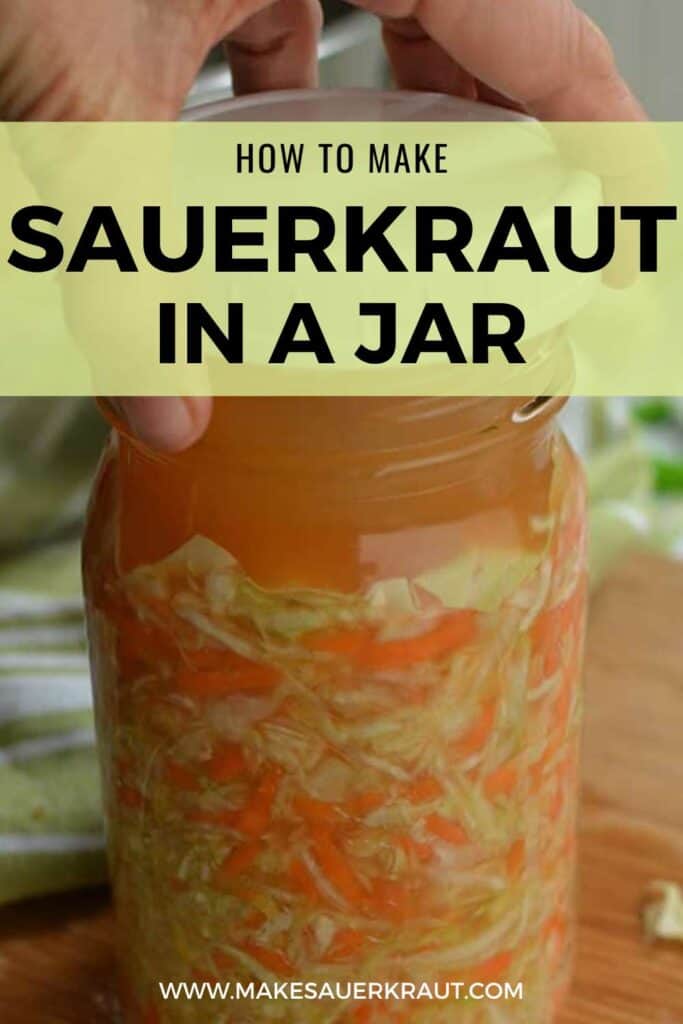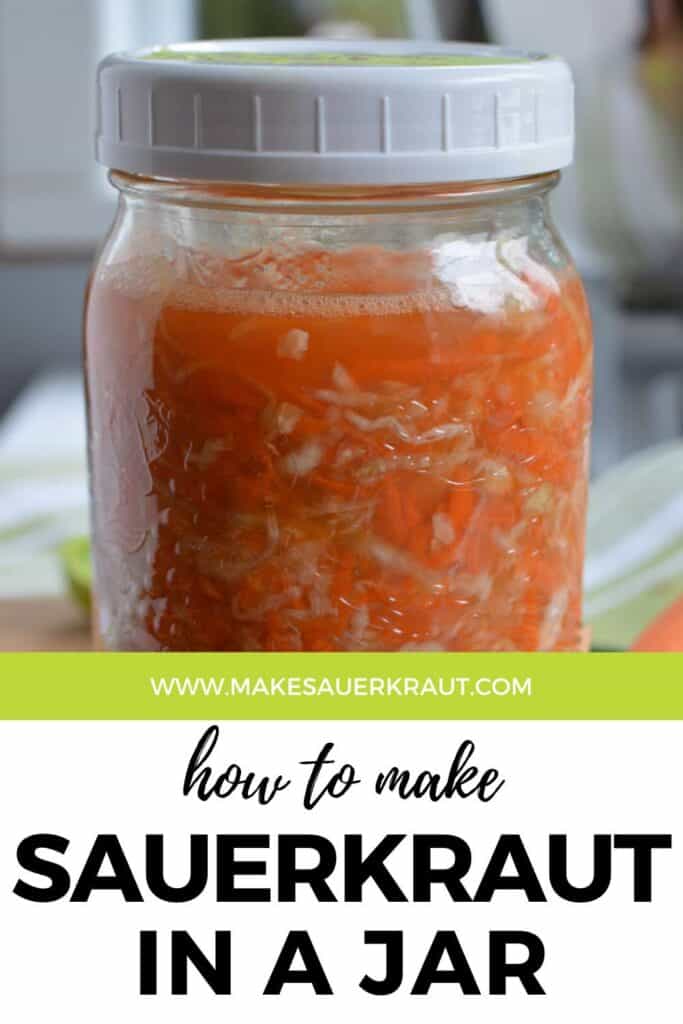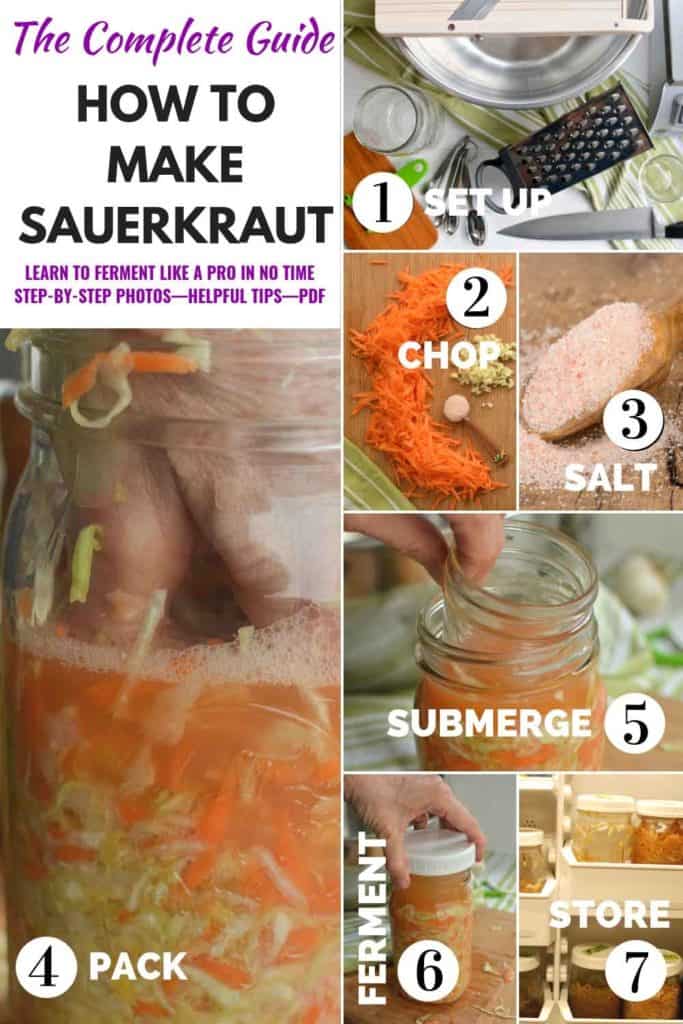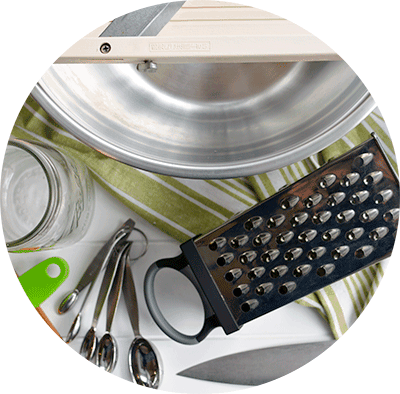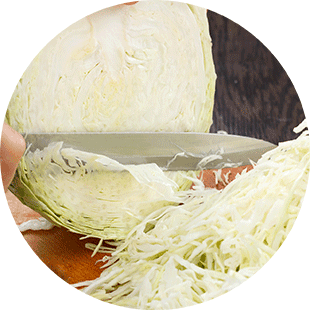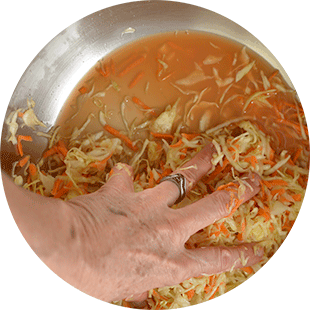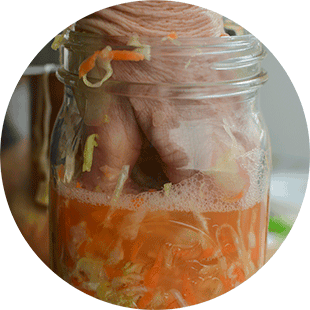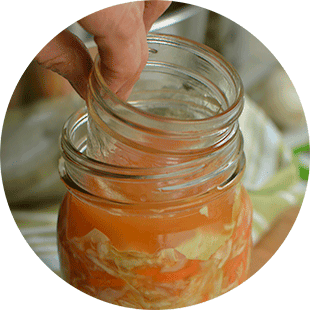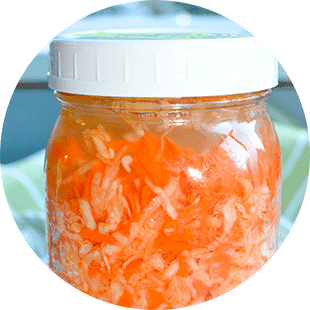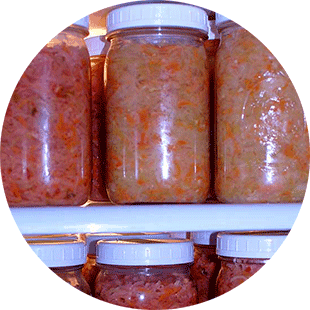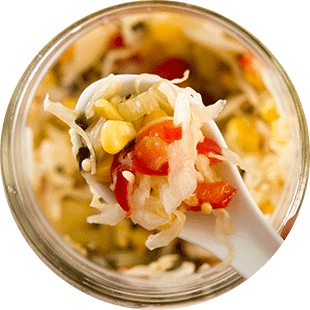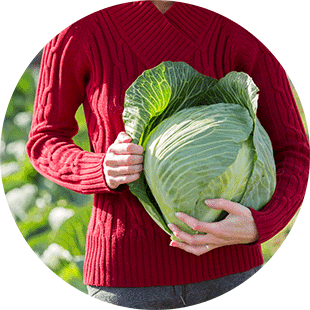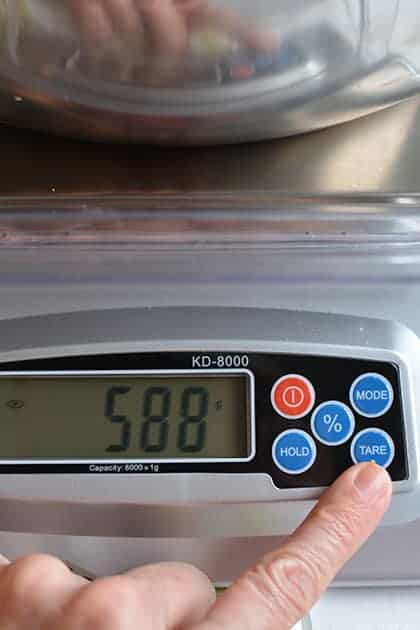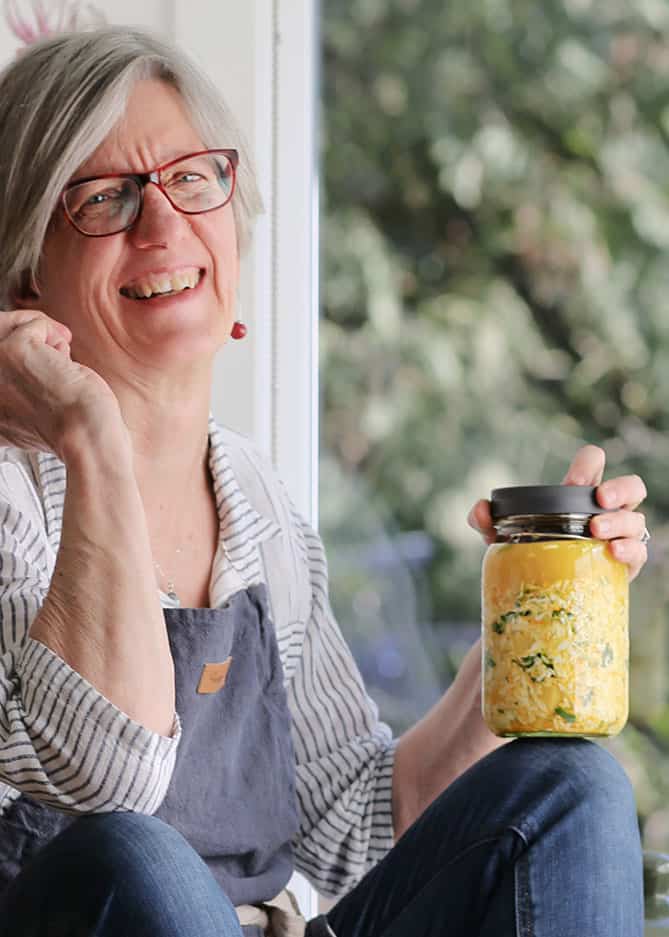From Jar to Genius: Mastering Fermentation with Our Ultimate Sauerkraut Guide. This step-by-step guide to making sauerkraut in a jar doesn’t just leave you with a delicious batch of sauerkraut; it equips you with a skill set that transforms everyday vegetables into probiotic, gut-healing wonders. Dive deep into our detailed instructions, complete with expert tips and helpful notes, and emerge not just with a jar of tangy sauerkraut but with fermentation skills that will last a lifetime.
Reader Jennifer commented: “Just wanted to thank you for sharing your knowledge and recipes. I just finished making sauerkraut—using sauerkraut cabbage, carrots, and garlic from a local farm. I got five jars from a 10lb cabbage! The way you lay everything out makes it so accessible. You answer questions I didn’t even know I had.” ★★★★★
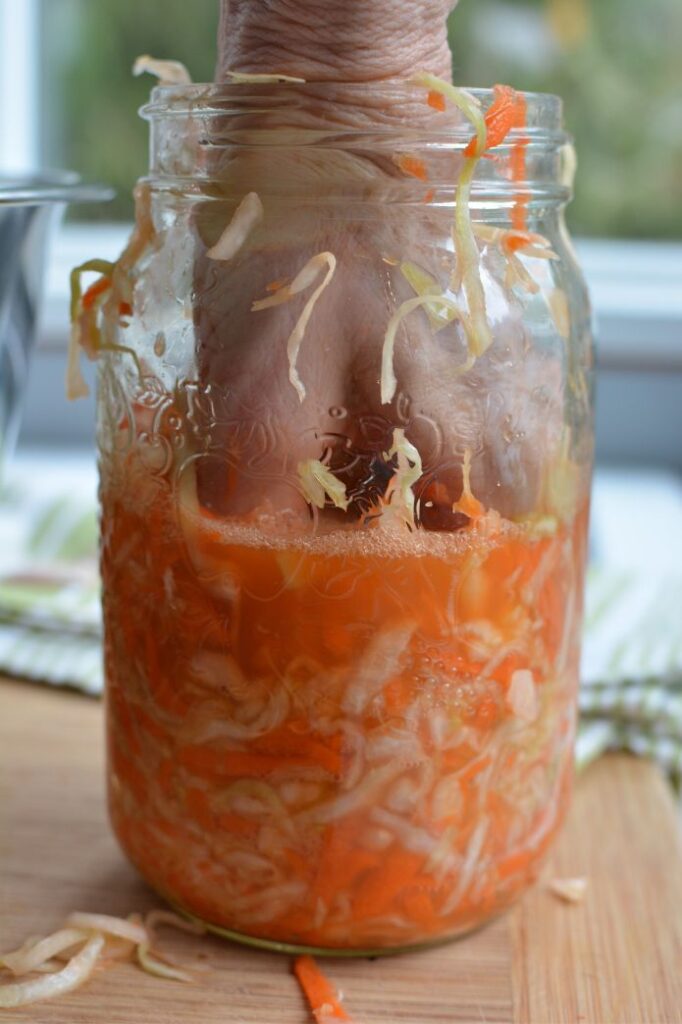
Welcome to ‘How to Make Sauerkraut in a Jar – The Ultimate Beginner’s Guide,’ your gateway to mastering the art of fermentation right in your kitchen.
Since its original publication in 2014, this guide has evolved beyond a mere recipe into a comprehensive fermentation masterclass, perfect for novices and seasoned pros.
With over 20 years of experience in making sauerkraut and having taught thousands the fine art of its creation, I bring a wealth of expertise to this guide.
This website is dedicated to transforming beginners into confident fermenters. My deep-rooted passion and extensive knowledge of fermentation are woven into every part of this comprehensive guide.
This guide is tailored to everyone—whether you’re a young enthusiast at 7, a senior at 77, someone still mastering kitchen skills, or an accomplished gourmet chef. You’re about to embark on a transformative culinary adventure that will:
- Quickly boost your confidence in fermenting sauerkraut.
- Make the process of enjoying this flavorful ferment feel effortless.
- Help you unlock the myriad health benefits, including enhanced digestion.
So, roll up your sleeves, and let’s dive into the fascinating process of turning ordinary vegetables into probiotic-rich sauerkraut. Your journey from jar to fermentation genius starts now!
Done with failed batches? Ready to turn on YOUR Fermentation Ninja skills?
Then, download a PDF copy of my expanded recipe: How to Make Sauerkraut in a Jar, AND… enroll in my Mini-Email Course. Ten days of bite-sized lessons on how to make sauerkraut in a jar.
Guaranteed success! All for FREE!
Contents
Here are the seven steps in our ‘How to Make Sauerkraut in a Jar – The Ultimate Beginner’s Guide,’ the most effective way to transform ordinary cabbage into mouthwatering sauerkraut. Really! 💥
STEP 1: SET UP. Gather Supplies & Set Up Scale
For this first step, you buy the vegetables you need (cabbage, carrots, garlic) and put together the necessary fermentation equipment: jar, weight, and lid.
Although there are many fancy—and quite effective—weights and airlocks to make fermentation easier, you can start with readily available items.
If you own fermentation weights and airlocks, use them. If not, wait until you have fermented a few batches. Then, you’ll know what additional equipment will work for your household needs and your fermentation preferences.
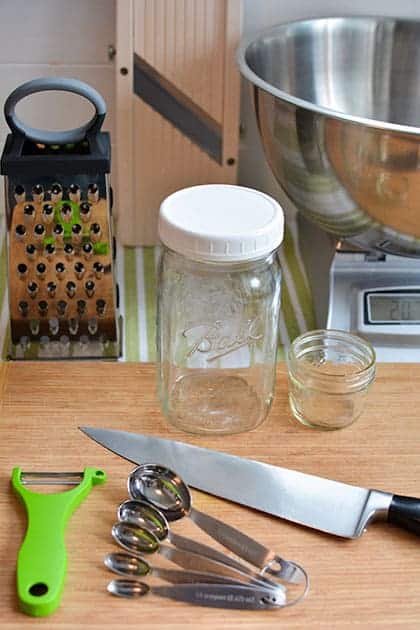
Gather Equipment
Here’s a list of what you’ll need. If you need to buy anything, there are recommendations below.
- Digital scale
- 1-quart (1 L) wide-mouth canning jar or similar-sized jar
- 4-ounce (125 ml) canning jar (jelly jar) or other fermentation weight
- Wide-mouth plastic storage cap or canning jar rim and lid
- Cutting board and chef’s knife
- Large mixing bowl
- Vegetable peeler, measuring spoons, and grater
- Kraut pounder (optional)
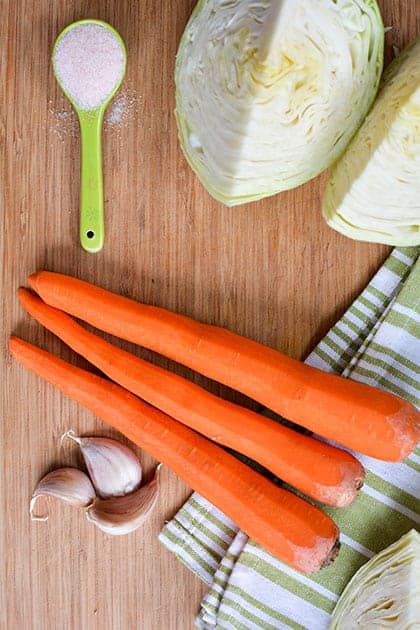
Purchase Ingredients
In this recipe, we make Sweet Garlic Sauerkraut: cabbage lightly seasoned with carrots and garlic. It’s a popular flavor, even for children.
If you prefer to ferment cabbage on its own, follow the recipe, omitting the carrots and garlic, though the carrots are nice to include. They add moisture and reduce the chance of your sauerkraut ending up dry.
- 1 medium head fresh green cabbage, approx. 2–3 pounds (approx.1 kg)
- 2–3 carrots (200 grams grated)
- 2–3 cloves garlic (20 grams minced)
- 1 level tablespoon iodine-free salt (16 grams)
- And, most importantly…
- Microbes (Naturally present on vegetables. The bacteria responsible for transforming humble cabbage into mouthwatering sauerkraut.)
Since you don’t want to include the weight of your bowl in your measurements, you need to know its weight.
Note: If your digital scale automatically shuts off after a few minutes, as most do, remember to subtract the weight of the empty bowl when adding cabbage in the next step.
SET UP Notes and Tips
- Use green cabbage. You’ll have the greatest success if you use the traditional round-headed green cabbage for your first few batches of sauerkraut.
- Use a digital scale and work in grams. The correct amount of salt is essential for safe and successful fermentation. You must weigh your cabbage and vegetables before adding salt.
- Write down the weight of your bowl. In STEP 2: PREP, add 800 grams (28 ounces) to this number. My favorite scale is the My Weigh KD8000.
- What should you use as a fermentation weight? If you can’t access the small 4-ounce (125 ml) “jelly” canning jar, see Fermentation Weights: Keep Your Ferment Below the Brine.
- Other lid options. If you can’t find the white plastic storage caps, you can use the rim and lid that comes with canning jars. I prefer the white plastic caps because they don’t discolor like the metal ones do when coming in contact with the sauerkraut.
- Make sure your salt does not contain iodine, sugar, or anti-caking agents that may interfere with the fermentation process. What is the Best Salt for Making Fermented Sauerkraut? I use Himalayan Pink Salt in all my recipes.
- You do not need to sterilize your jar; just wash it with dish soap and rinse thoroughly.
Special Fermentation Tools
If you don’t have the equipment you need in your kitchen, the following jars, weights, and lids are my top recommendations.
Fermentation Jar
Canning jars have endless uses around your home, so don’t be afraid to have more on hand than you need for fermentation. I like the Ball brand because the measurements (standard & metric) are stamped on the side.
Fermentation Weight
A fermentation weight holds your packed sauerkraut below the brine.
Fermentation Lid
A fermentation lid prevents excess air from entering your jar but also allows gases to escape.
Scale & Salt
The bacteria that make fermentation happen work best in a set range of salinity. Weigh your cabbage and vegetables on a scale so that you can add the correct amount of salt.
FUN FACT:
Sauerkraut contains live and active probiotics that act as your first line of defense against various harmful bacteria or toxins that might enter your body.
Step 2: CHOP. Chop Your Vegetables & Cabbage
In Step 2: CHOP, you prepare and weigh your ingredients. Your bowl should contain 800 grams (1¾ pounds or 28 ounces) of vegetables and cabbage.
When making sauerkraut, you first prepare the flavoring ingredients—carrots, ginger, radish, caraway seeds, or whatnot—then add sliced cabbage. This allows you to add as much sliced cabbage as necessary to hit 800 grams on the scale.
Why?
800 grams (1¾ pounds or 28 ounces) is the perfect amount of cabbage and vegetables to mix with 1 tablespoon (16 grams) of salt to create the right saltiness of brine to ensure perfectly fermented sauerkraut.
And it’s the perfect amount of sauerkraut to pack into a 1-quart )1-liter) jar. So, we always slice just enough cabbage to have 800 grams of vegetables AND cabbage.

First, peel and grate two to three carrots (about 200 grams grated). Add these to your bowl. Finely mince two to three garlic cloves (20 grams works well), and add these to your bowl.
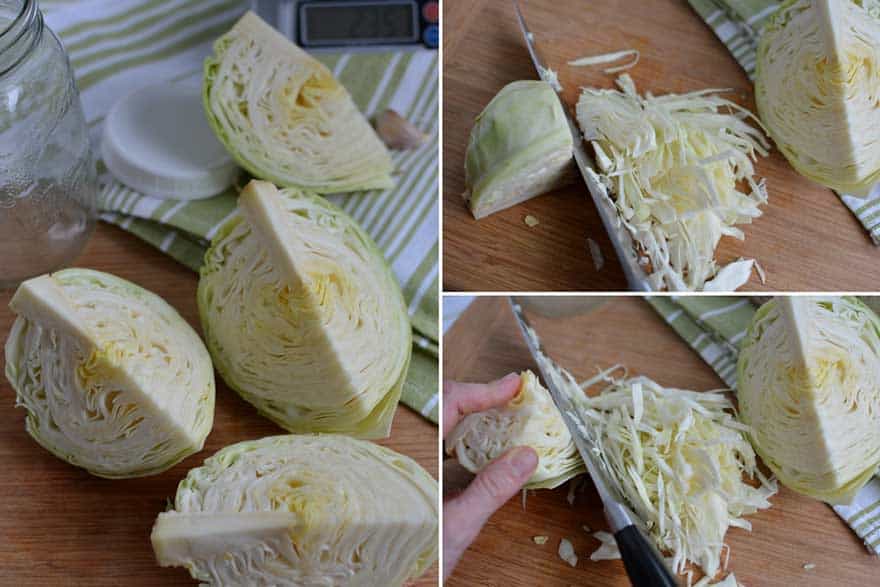
Then, prepare your cabbage. Discard any limp outer cabbage leaves, setting aside one of the cleaner ones for use at the end of STEP 5: SUBMERGE & SEAL.
Quarter the cabbage, leaving the core in. The core helps hold the layers of cabbage together, making the slicing job easier.
Place a cabbage quarter on one of its sides and slice the cabbage crosswise into thin ribbons.
When you get to the core, turn it as necessary and slice until only the core remains. (I don’t use the core; I feed it to the worms in my compost pile.)
Other Ways to Slice Cabbage
Check out my post, How to Slice Cabbage [Which is the BEST for Perfect Sauerkraut?] for a thorough coverage on the topic. Here are some basic guidelines.
Can I use a food processor? I don’t find a food processor helpful for slicing cabbage. By the time I set it up and cut the cabbage into just the right-sized chunks to fit in the feed tube, I could have finished slicing with my mandoline.
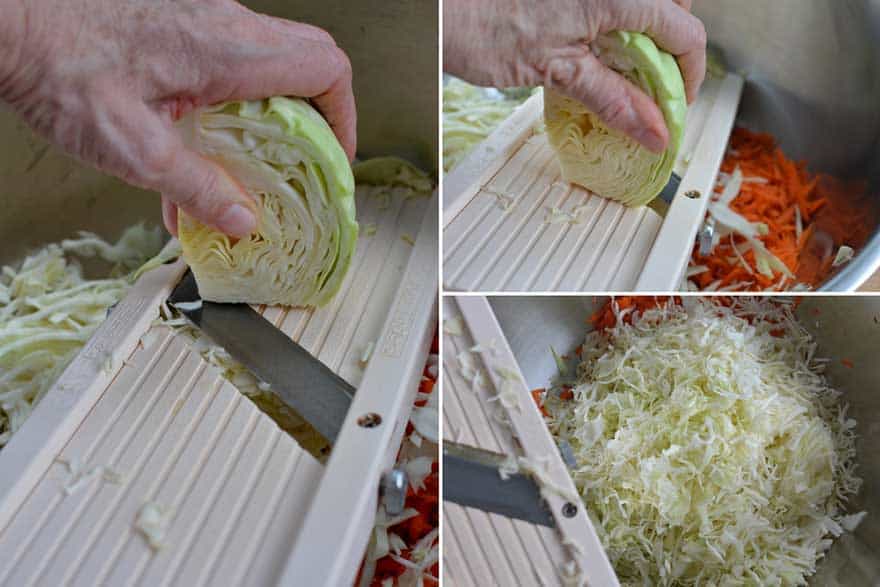
I highly recommend buying a wide mandolin for effortlessly slicing cabbage into beautiful, thin slices. I bought one a few years back, and it’s how I slice all my cabbage now.
See Fermenting Supplies for Sauerkraut & Vegetables [The Classics, The Latest, The Greatest] for a recommended brand along with “No-Cut” safety gloves that make slicing safer when working with such a sharp blade.
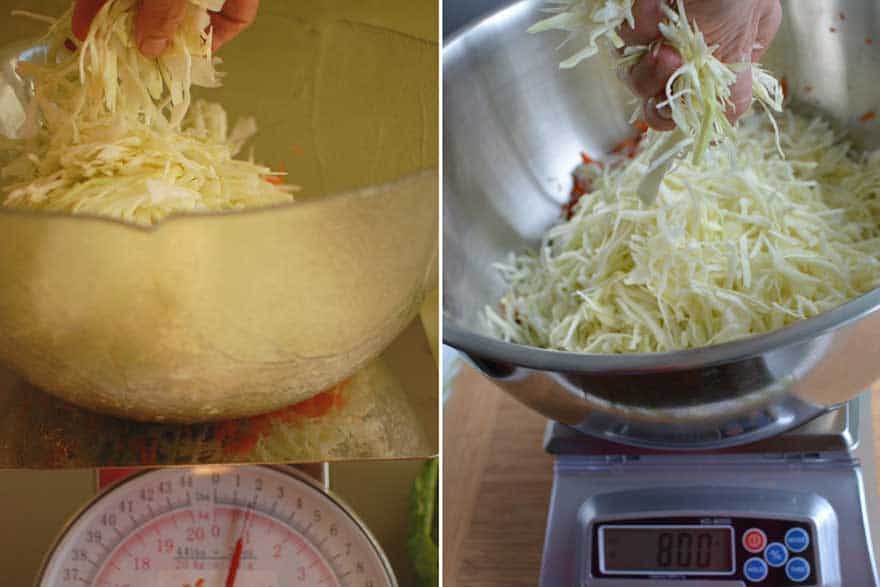
Add the sliced cabbage to your bowl until the weight of vegetables and cabbage is:
- 800 grams,
- 1¾ pounds,
- 28 ounces, or
You are now ready for the magic.
CHOP Notes and Tips
- Leave the core in. It holds the layers of cabbage together and makes slicing easier.
- Slice towards the core until it gets too thick, and then toss the core. Often, the core is not as sweet as the rest of the cabbage and can be a bit tough, so I compost the cabbage core.
- Food processor? Some fermenters love to use a food processor to slice their cabbage. If you do, the feed tube will result in nicer slices than the S-blade. If you use the S-blade, be sure not to over-process the cabbage.
- Consider a mandolin for thin, ribbon-like slices. I recommend the wide-body Benriner. Here is a quick video on how to use it. I leave the core in; there is no need for the ice bath.
- When to use the food processor? When making large batches, the food processor is handy for grating large amounts of carrots, mincing lots of garlic, and prepping quantities of other vegetables in your recipe.
- Follow the 75-25 Rule. For a healthy ferment, keep at least 75% of the weight in cabbage and no more than 25% of the total weight as “flavoring” ingredients.
FUN FACT:
Sauerkraut is high in digestive enzymes that help to break down starches, proteins, and fats.
STEP 3: SALT. Create Your Brine
In Step 3: SALT, you add salt to the prepared vegetables and sliced cabbage to create the brine in which your sauerkraut will ferment. Believe it or not, that big bowl of sliced cabbage will fit into your jar.
Salt pulls water out of the cabbage and vegetables to create an environment where the good bacteria (mainly lactobacillus) can grow and proliferate, and the bad bacteria die off.
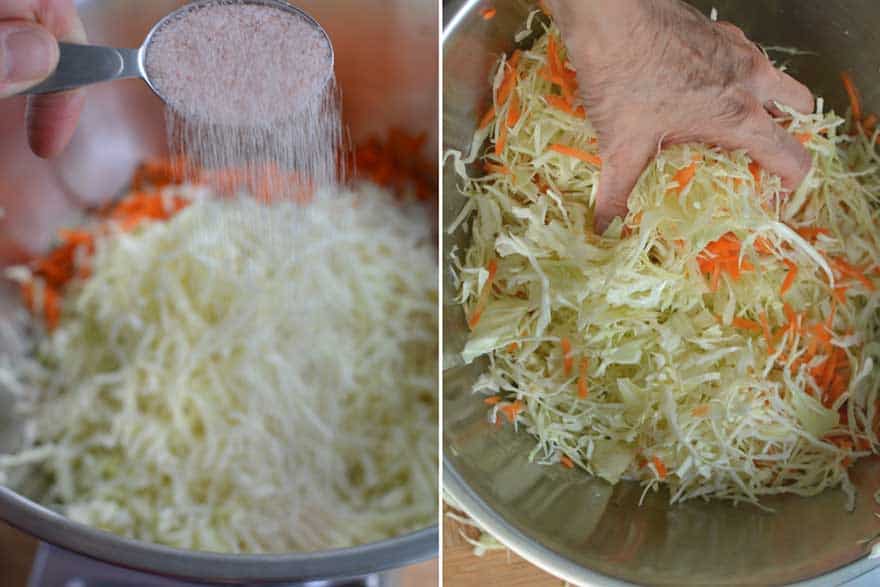
Sprinkle vegetables and cabbage with 1 tablespoon (16 grams) of salt and mix well.
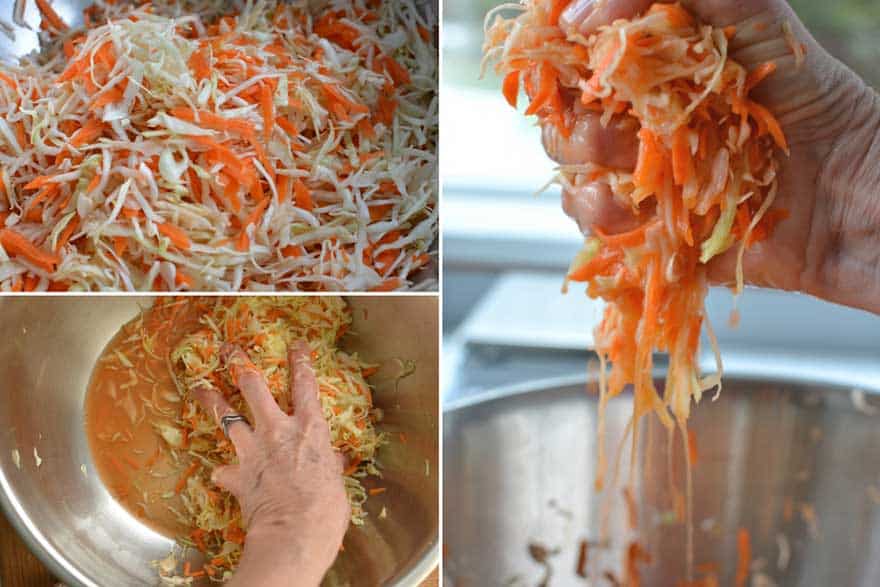
Massage and squeeze the vegetables with strong hands until moist, creating the brine. You should be able to tilt the bowl to the side and see a good-sized puddle of brine, about 2–3 inches in diameter. This process can take anywhere from 2 to 10 minutes.
Salt Notes and Tips
- No-Pound Sauerkraut. If you want the salt to work for you, leave the salted cabbage alone for 20 minutes to an hour. Return later, and you’ll notice the cabbage is glistening with “sweat.” You will not have to massage the cabbage much at all.
- Are your hands not strong enough to massage the cabbage? One of my readers shared that she uses the dough hook of her KitchenAid mixer to massage the salted cabbage slowly.
- Age of cabbage and brine amount. The fresher the cabbage and the higher the moisture content, the quicker the brine will be created. If you’re making sauerkraut in the fall with fresh cabbage, you’ll see this for sure. On the other hand, if you’re making sauerkraut with cabbage that has been stored for months, you’ll find it harder to create the brine, and there’ll be less of it.
- Weigh your salt. If you have a digital scale and the personality for exactness, you can use your scale to weigh the correct amount of salt. Salt by Weight for Delicious Sauerkraut… Batch after Batch
FUN FACT:
Sauerkraut has high levels of Vitamin C for collagen production and as a natural antioxidant for immune system support.
STEP 4: PACK. Pack Mixture into Jar
In Step 4: PACK, pack the cabbage mixture into your jar.
Your big bowl of cabbage and carrots has shrunk to a manageable, moist mass. The brine that was created will keep your sauerkraut safe from harmful bacteria while it is fermenting.
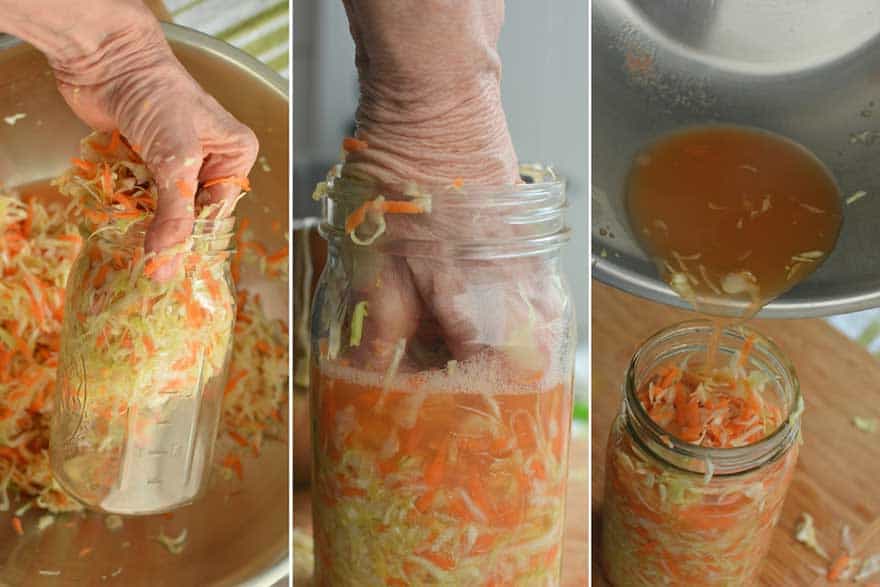
Grab handfuls of the salty, juicy cabbage mixture and pack it into your quart-sized wide-mouth canning jar, periodically pressing the mixture down tightly with your fist or a large spoon so that the brine rises above the top and no air pockets remain.
To keep the mess to a minimum, hold the jar in one hand—my clean hand—and pack with the other hand, holding everything over the bowl.
Use firm pressure, just enough to remove large air pockets but not so hard as to possibly break the jar.
Be sure to leave at least 1 inch of space between the top of the cabbage and the top of the jar. This should happen automatically because we weighed the right amount of cabbage to fit in your jar.
Pour any brine left in your mixing bowl into the jar and scrape out any loose bits stuck to the sides of the bowl.
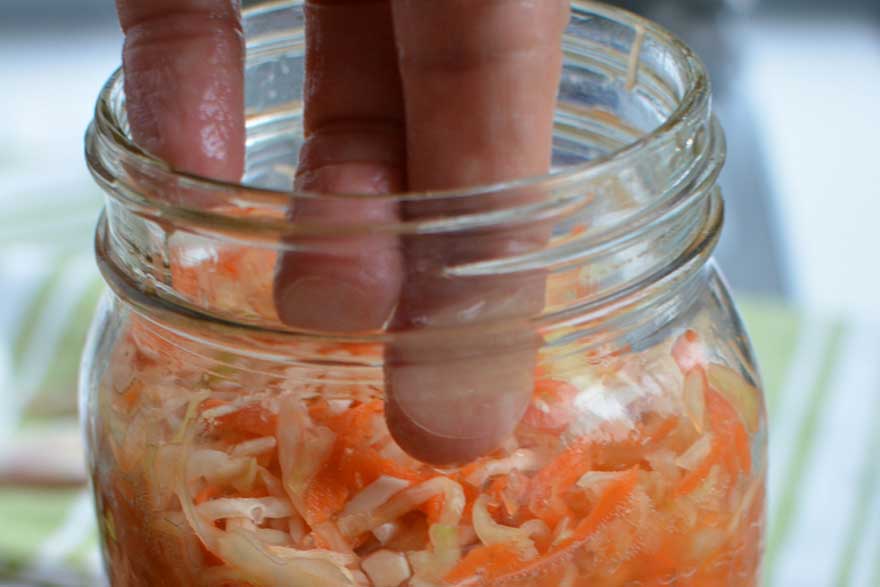
Lastly, wipe down the outside of the jar and push down any tidbits on the inside that may remain above your packed ferment. Remember: “Under the brine, makes it fine!” 🙂
PACK Notes and Tips
- Kraut Pounder. If your hand is too large to fit into the jar (or if your hands are irritated by the salty brine), use a Kraut Pounder, a large spoon, the end of a rolling pin, or a meat pounder. I share some options on my fermenting supplies page.
- Funnel. One of my readers shared how useful a funnel has been for filling her jars.
FUN FACT:
Sauerkraut is rich in fiber for bowel health, lowering blood cholesterol, and controlling blood sugar levels.
STEP 5: SUBMERGE AND SEAL. Hold Below Brine
In Step 5: SUBMERGE AND SEAL, you use a Floaties Trap, a weight, and a lid to keep your fermenting mixture submerged in the brine and not exposed to air.
Air is bad for the fermenting sauerkraut and can enable the bad bacteria to grow and proliferate, creating mold and other undesirable by-products.
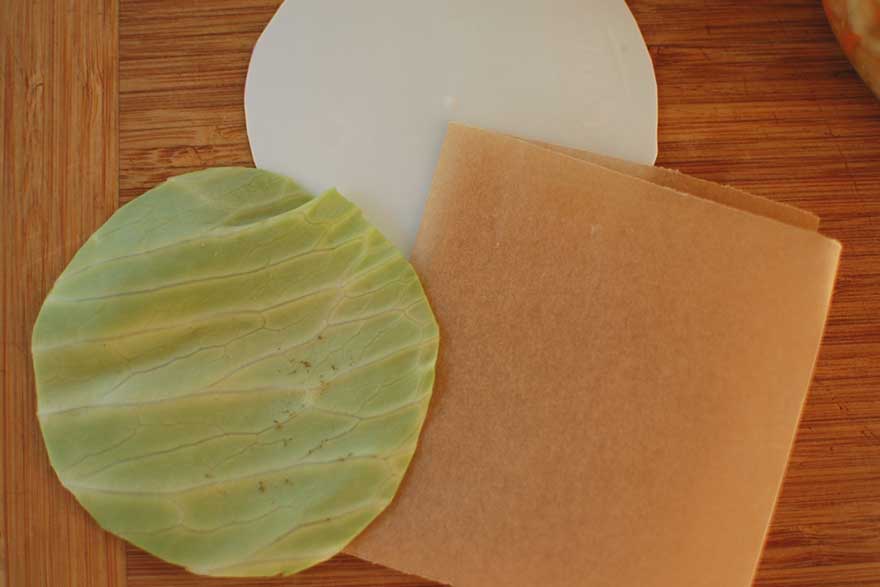
Floaties Trap. Take that cabbage leaf you saved in Step 1, and tear it down (Or, be a bit obsessive. Trace the jar lid and cut it to size.) to fit in the jar.
Did you forget to save a cabbage leaf? No problem. You can fold a narrow piece of parchment paper to size or even cut an old plastic lid to size.
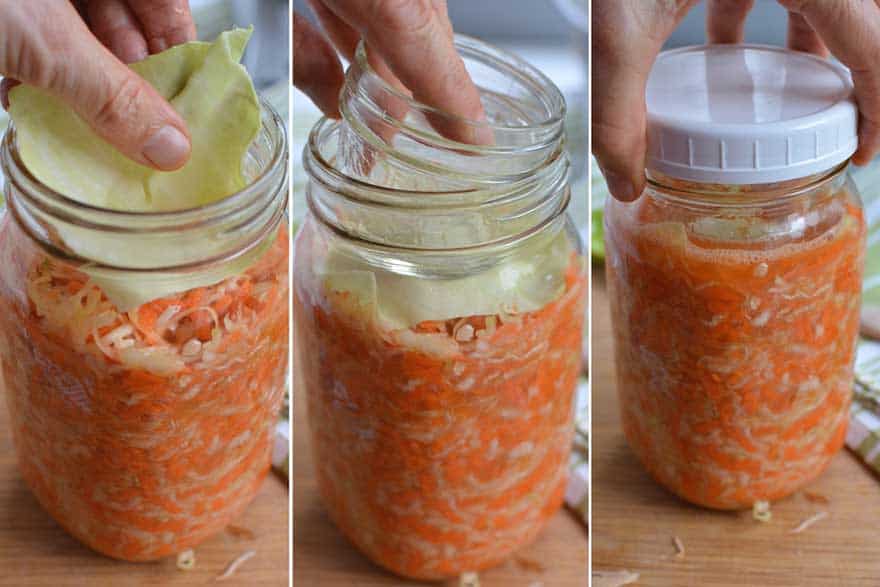
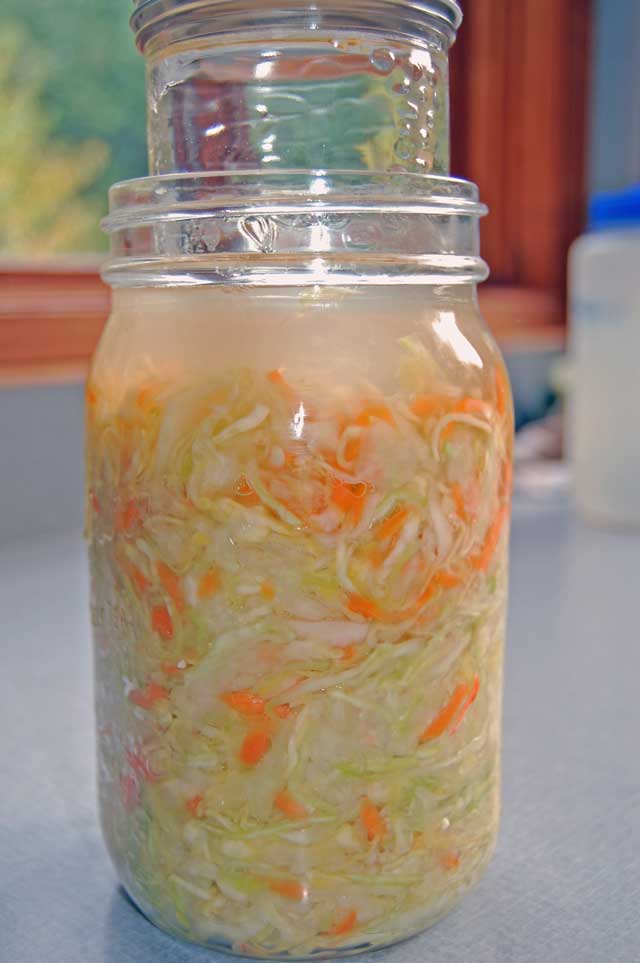
Place your torn cabbage leaf over the packed cabbage’s surface to prevent bits from floating to the surface.
To hold the vegetables below the brine, place the 4-ounce jelly jar on top of the cabbage leaf, right side up, with its lid removed. The jar might stick out of the top of the jar a bit. Don’t worry: when you screw on the lid, it will get pressed down into place.
Lightly screw the white plastic storage lid onto the jar. By leaving the lid somewhat loose, CO2 gases that will build up during fermentation can escape.
If the jar has a lot of brine, you may have to remove some to put the lid on without the liquid overflowing.
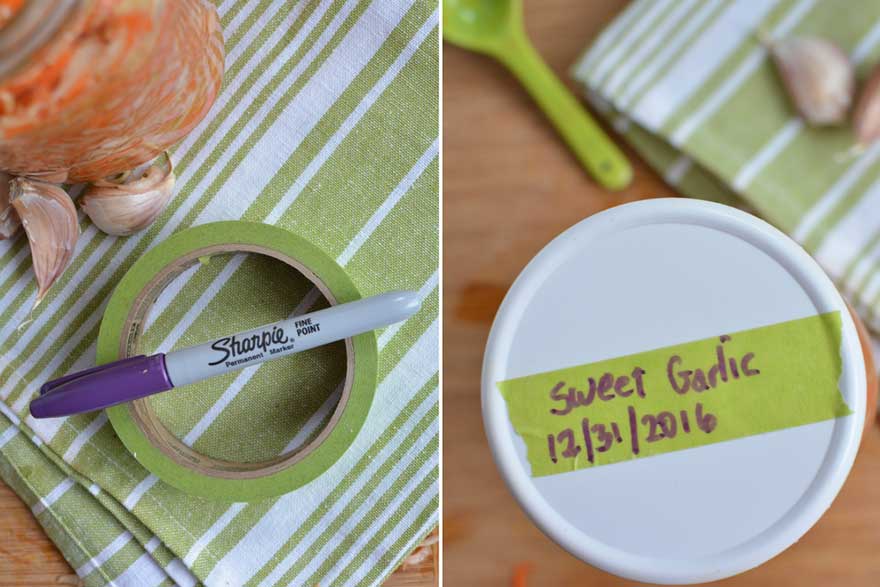
I like to label my jars using painter’s tape and a permanent marker. I note the flavor of the sauerkraut I made and the date I started fermenting.
SUBMERGE Notes and Tips
- Floaties Trap. If you forgot to save a few cabbage leaves for your Floaties Trap, sift through your cabbage scraps and see if you can retrieve some. If that doesn’t pan out, a piece of parchment paper, cut to size, works well. Wax paper should also do the trick.
- Other ideas for Weight? If you don’t have access to the small “jelly” jar for a weight, search your house for other small jars: a shot glass or perhaps a small mushroom jar. Some use a clean rock. You can also use a food-grade freezer bag filled with salt water (1 tablespoon salt to 2 cups water). More ideas in Fermentation Weights: Keep Your Ferment Below the Brine.
- If there is not enough brine to cover your packed cabbage mixture by 1 inch, go ahead and put the lid on your jar and check it the next day. If there is still not enough brine, dissolve 1 tablespoon salt in 2 cups water and pour this in.
- If all the brine does not fit in your jar, pour it into another small jar, cap it, and leave it on your counter. Use to add brine to the jar later in the fermentation process, if needed.
FUN FACT:
The Germans gave sauerkraut its popular name, but the Germans did not invent sauerkraut.
STEP 6: FERMENT. Ferment for 2 to 4 Weeks
In Step 6: FERMENT, the friendly bacteria work for you while you watch and wait. They know how to make sauerkraut FOR YOU! 🙂
Now sit back and relax as the friendly bacteria eat the sugars in the cabbage and carrots, multiply, and release copious amounts of lactic acid, which creates an environment inhospitable to pathogenic bacteria, acts as a natural preservative for your ferment, and gives your sauerkraut that familiar tang.
Can you wait seven days to taste the tangy crunch?
During this time, the friendly bacteria that live on the vegetables will eat the sugars in the cabbage and carrots, multiplying and releasing copious amounts of lactic acid that act as a “poison” for any bad bacteria. Let them work while you rest.
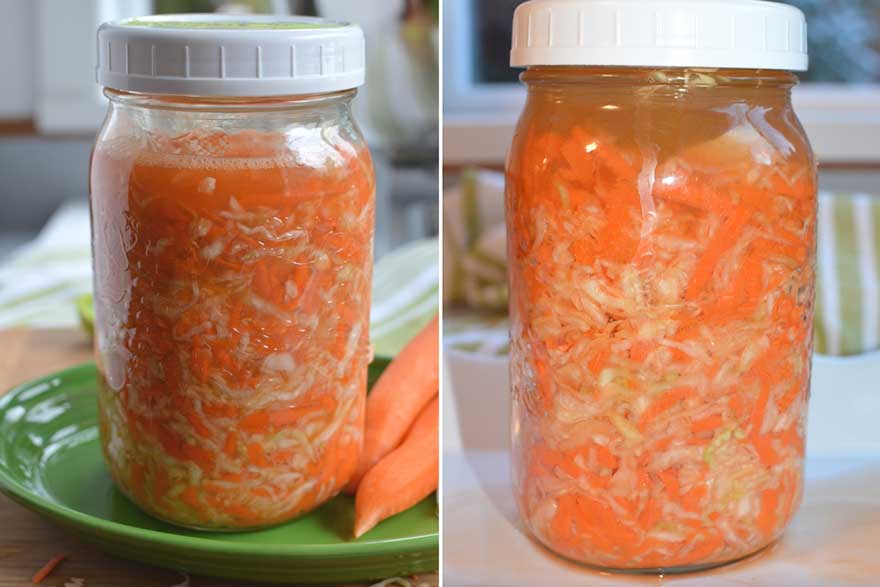
Place your jar of fermenting sauerkraut in a shallow bowl (to catch the brine that may leak out during the first week of fermentation) out of direct sunlight.
You can cover it with a towel if you’d like, although I don’t. I enjoy watching the changes my beautiful kraut artwork undergoes over the ensuing days or weeks. I just finished packing the jar on the left; the jar on the right shows how much brine was created in just 24 hours.
The ideal fermentation temperature is between 65 and 70°F (18–21°C). The lower the temperature, the slower the fermentation. The higher the temperature, the faster the fermentation. Ideally, you want the temperature to be somewhat stable, not fluctuating more than 5 degrees in either direction.
For what to expect as your sauerkraut ferments, see SALTY Cabbage to SOUR Sauerkraut: Fermentation Signs to Monitor
The first week is when you’ll see the most action in the jar. The mixture will get bubbly and the brine will rise in the jar, likely seeping out from under the lid. Your home may even start to smell like sauerkraut! During this first week, keep an eye on the level of the brine. It will rise and fall with the temperature in the house.
If the lid is bulging or you don’t see brine seeping out, carefully loosen the lid just a tad, stopping the second you hear gases escaping or see liquid seeping.
Should the brine level fall (very unlikely) and remain below the level of the sauerkraut during this first week, dilute 1 tablespoon of salt in 2 cups of water.
Pour some of this brine over the sauerkraut (removing the little jar first) until it just covers the mixture. Put the little jar back in, screw the lid on lightly, and let the fermentation continue.
Don’t worry if the brine disappears after the 7- to 10-day mark. By this time, you’ve created a safe environment in which the bacteria that would cause mold or slime have been chased away by the beneficial bacteria produced during fermentation. Here’s how my jar of sauerkraut looks over time:
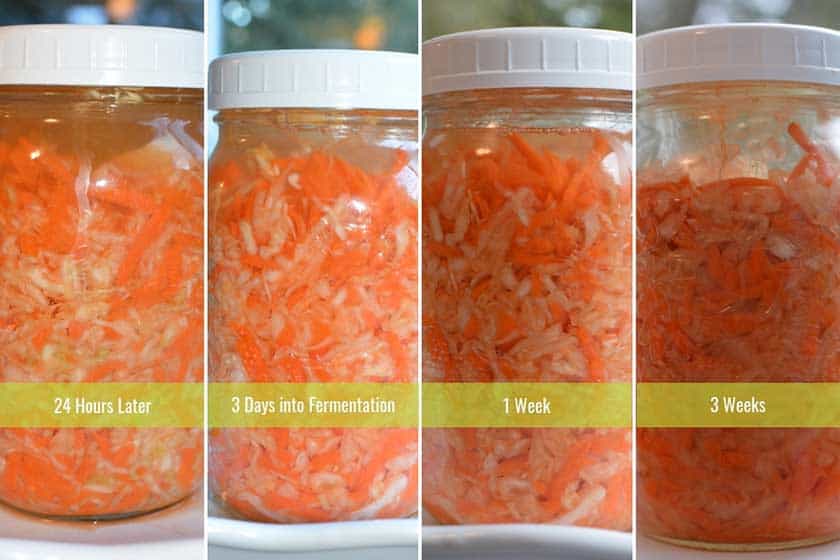
At the 1-week period, open the jar, pull out the small jar, and smell and taste your sauerkraut. At this point, you can start eating it or let it ferment for a bit longer.
You can ferment your sauerkraut for up to 4 weeks. The longer you ferment it, the greater the number and variety of beneficial bacteria that can be produced. Research I’ve come across indicates that bacteria numbers peak at 21 days. Keep that in mind, but ferment for flavor. You have to like the stuff to eat it. 😀
I suggest that people ferment their first jar for 1 week, and then the next jar for 2–4 weeks, tasting it at 1-week intervals to determine the level of tang and crunch they personally prefer. See How Long to Ferment Sauerkraut?
FERMENT Notes and Tips
- If the brine in your jar seems to disappear suddenly, don’t panic. This is due to a few things. Cooler temperatures can pull the brine back into the sauerkraut. When the house warms up, brine levels usually rise again. Atmospheric pressure will also affect brine levels.
- Should the brine level fall (very unlikely) and remain below the level of the sauerkraut during the first week, dilute 1 tablespoon of salt in 2 cups of water and pour some of this brine over the sauerkraut (removing the little jar first) until it just covers the mixture. Put the little jar back in, screw the lid on lightly, and let the fermentation continue.
- Keep your fermenting jar in a shallow dish to protect your kitchen counter and avoid cleaning up a mess.
- Don’t worry if the brine disappears after the 7- to 10-day mark. By this time, you’ve created a safe environment in which the bacteria that would cause mold or slime have been chased away by the beneficial bacteria produced during fermentation. I’m finding that there can be so many air bubbles mixed in with the fermenting sauerkraut that it expands, making it look like there is no brine. Pushing down on the weight, sliding a butter knife along the inside of the jar, or poking the sauerkraut with a bamboo skewer will release all the air bubbles and allow the sauerkraut to condense back down into the jar and brine to recover the top of it.
- Music and Bubbles. You will hear an occasional fizzy sound of air escaping the jar. This is normal and is caused by carbon dioxide escaping the jar. It is one sign that fermentation is happening.
What follows are some images readers left in the comments below for you to see the many ways that your jar of sauerkraut may look.
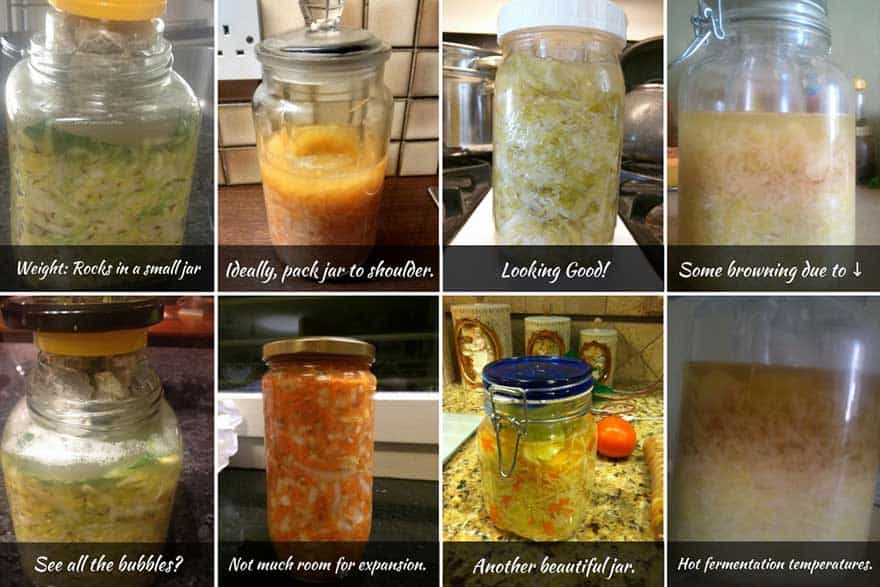
FUN FACT:
Sauerkraut originated nearly 2,000 years ago in ancient China. In summer, slaves building the Great Wall of China lived on cabbage and rice. In winter, the cabbage was preserved with rice wine, which soured the cabbage to keep thousands of laborers healthy in the worst of conditions.
STEP 7: STORE. Store in Refrigerator for up to One Year
After your sauerkraut has fermented to your liking, it’s time to move it to cold storage until you are ready to add its probiotic-rich flavors to your meals effortlessly.
Refrigeration slows the fermentation process to the point where you won’t notice significant changes in texture.
Rinse off the outside of the jar. You can take the little jar out. Clean the rim if necessary (sometimes it can get sticky from the brine that overflows), and screw the lid back on tightly.
Add to your label how long you fermented the contents.
Enjoy a forkful or two of your sauerkraut with your meals. It will continue to ferment – aging like a fine wine – but much slower than before. If the flavors are too intense, leave it – in your refrigerator – for a month or two and then sample it. You will be amazed at how the flavors have changed.
If successfully fermented (tastes and smells good), your sauerkraut can be kept in your refrigerator for up to a year.
STORE Notes and Tips
- The ideal temperature at which to store sauerkraut is 35-38°F (2-3°C), which happens to be the typical temperature of a refrigerator. With these temperatures, you won’t notice much change in the texture over 12 months, the typical storage length for sauerkraut. If you store your sauerkraut in a cool basement at 55°F (12.7°C), you will notice your sauerkraut getting softer as the months progress.
- Not enough room in your refrigerator? Consider a second refrigerator – even a small dormitory-sized one – if you have a place for it.
- Clean up your refrigerator. Doing so makes for a less expensive solution. There is more room in there than you realize. Toss out old or moldy mystery jars and organize them. With today’s deeper refrigerators, you’ll find a goldmine of space at the backside. This is where I can store 7-10 jars of sauerkraut.
- Canning is not recommended for fermented foods. The high heat destroys most, if not all, of the beneficial bacteria.
- Does your refrigerated jar of sauerkraut look dry? You may notice that there is not always brine covering your jars of sauerkraut in the refrigerator. This leaves the top portion of your sauerkraut exposed to air and possible loss of nutrients. I notice this happens when the sauerkraut is cold, as it seems to contract and “drink” up all the brine. You may add more brine as I used to, but it dilutes the flavors and may cause browning.
- DIY Root Cellar? Freeze? Dehydrate? See: 5 Ways to Store Fermented Sauerkraut [One is Controversial]
FUN FACT:
The heat processing of canned sauerkraut destroys live probiotics and viable digestive enzymes.
The Best Part. ENJOY! ENJOY! ENJOY!
With a jar of sauerkraut at the ready in your refrigerator, you will be able to add an extra dimension to any meal effortlessly, unlocking flavors you never knew existed and reaping the added bonus of improved digestion to supercharge your health.
When trying to incorporate sauerkraut into your diet, keep it simple. And remember, if you want to take advantage of the benefits of lacto-fermented sauerkraut, don’t destroy the good enzymes and probiotics by heating your sauerkraut.
It’s fine to stir sauerkraut into a warm bowl of soup or sprinkle some on the top of your meal. You just don’t want to cook or bake with it.
Or… if your favorite recipe calls for sauerkraut, just be sure to serve some uncooked sauerkraut alongside it. The best of both worlds.
Here are a few ways to enjoy your tasty, probiotic-rich sauerkraut!

A condiment to the Main Meal
The easiest way to add sauerkraut to your diet is as a condiment. It pairs well with almost anything.
Don’t like cold sauerkraut? Try to remember to pull it out of the refrigerator as you begin to prepare the meal.
Almost Instant Salad
In a bowl, mix lettuce, a few forkfuls of sauerkraut, some brine, a splash of olive oil, a squeeze of lemon, and fresh ground black pepper. For a more filling salad, add chunks of cheese or leftover meat.
Quick Pick-Me-Up
Have that afternoon slump and wish you could take a nap? Try a few bites of sauerkraut – yes, you can eat it right out of the jar – and see if you are soon re-energized.
Hot Dog!
Last but not least: add sauerkraut to that hot dog for the classic combination, and for a bit of heat, add a sprinkle of red pepper powder, the same powder that is used to make kimchi.
For more ideas, see: 50 Tasty Ways to Enjoy Sauerkraut {Simple Snacks to Yum Dishes}
ENJOY Notes and Tips
- Keep it simple. You can come up with all sorts of creative ways to eat sauerkraut, but the simplest is either as a condiment with your meal or mixed into a salad.
- Serve straight from the jar. Place a couple of jars of sauerkraut on the table and let each member of your family use their clean fork to put some of their favorite sauerkraut on their plate. If you’re lucky enough to have brine still when you get to the bottom of the jar, drink its probiotic-rich goodness or pour it into another finished ferment in your fridge.
- Don’t like to eat cold sauerkraut? Either remove it from the refrigerator an hour before or at the beginning of your meal, place it on your plate, and give it some time to come to room temperature. Placing it on a warm dish is another way to take the chill out.
- Eat your probiotic-rich sauerkraut within a year. If properly fermented, it can last much longer, but you’ll start to see browning in the top layer of the jar, especially with sauerkraut containing beets. This browning indicates a loss of vitamins, mainly Vitamin C.
- Enjoy the subtle health benefits. Improved digestion, better energy, and a stronger immune system can all be yours as you nourish your body with sauerkraut, the fermented foods Superstar.
- If this is the first time for you to eat sauerkraut, go slow, especially if you have compromised digestion. You can start with just a sip or two of the brine and then move on to eating a small bite of the sauerkraut, watching for symptoms. Take about a month to work your way up to two small (1/4 cup) servings per day.
- Are you experiencing gas, diarrhea, or other digestive symptoms? You’ve most likely introduced more bacteria and fiber into your diet than your body can handle. See the previous tip and scale back your consumption.
- Salty sauerkraut? The type of salt you use will determine how salty your finished sauerkraut tastes. I use Himalayan Pink Salt, a mineral-rich salt, in all my recipes.
FUN FACT:
In the 18th century, explorers like Captain Cook used sauerkraut to prevent scurvy during long sea voyages, bringing as much as 25,000 pounds of the Vitamin-C-rich ferment along on voyages.
FAQs
In this section, I answer some of your most frequent questions about fermentation.
What is the best temperature to ferment at?
The ideal fermentation temperature for producing sauerkraut with the most complex flavors is between 65 and 70°F (18–21°C). Ideally, you want the temperature to be somewhat stable, not fluctuating more than 5°F (3°C) in either direction.
If you live in a warm climate, many are able to create a cooler space using an ice chest with frozen jugs of water. See 11 Cool Fermentation Tips for Hot Weather for further details.
Is my home-fermented sauerkraut safe to eat?
Yes. Very.
During fermentation, the bacteria eat the sugars in the vegetables and cabbage and make lactic acid, the vinegar-like tang you taste when you eat fermented vegetables. As this happens, the pH of your jar of sauerkraut is lowered to a range at which harmful bacteria cannot survive. The result is a safe, preserved, ready-to-eat ferment containing trillions of beneficial bacteria.
As long as the color of your cabbage has faded from bright to dull green, there are no noxious, knock-your-socks-off odors (you’ll know), and it tastes tangy (somewhat like vinegar), it is perfectly safe to eat.
How do I protect my sauerkraut from mold?
Mold grows from mold spores everywhere in the air and begins growing when they land on a wet surface with nutrients (such as your bits floating on the surface of your ferment). They can actually survive in acidic foods, so it’s not necessarily the acidity that deters them.
To reduce the chances of mold growing on your sauerkraut, keep it under the brine, use the right amount of salt, and ferment at ideal temperatures. Here are some ideas for how to keep your ferment below the brine:
3 Key Items for Keeping Your Ferments Safe [BELOW THE BRINE]
Why is my sauerkraut dry?
You can end up with a batch of dry sauerkraut for many reasons, the most common ones being fermenting with old cabbage, not including moisture-rich vegetables in your sauerkraut, and fermenting in the smaller environment of a jar (a good way to learn) vs. a large crock.
I have a complete post devoted to this—Dry Sauerkraut? 17 Transformative Tips—with many more tips and suggestions. Here are a few:
Use fresh cabbage. Even though cabbage is approximately 92% water, if it is June and you’re about to make a batch of sauerkraut, that cabbage has most likely been in cold storage for six months and will have lost much of its moisture.
Loss of moisture means less brine. The closer to harvest that you purchase your cabbage—and make sauerkraut—the more brine it will produce and the less chance there is of dry sauerkraut.
Add moisture-rich vegetables. The carrots in this recipe add valuable moisture—and flavor. When packing your jar, if you don’t have enough brine, that’s the time to add moisture. You could add the juice from one lemon or some grated radish.
Graduate to fermenting in a water-sealed ceramic crock. I love the ease and simplicity of fermenting in a jar, but the larger environment of a crock can be a game-changer, both in flavor and moisture.
In addition, brine levels ebb and flow throughout the fermentation process and with temperature fluctuations. There will be copious brine during the first active phase of fermentation and less during the later, quiet stages. Water is naturally pulled back into the cells of the cabbage in the cold of your refrigerator.
How will I know when my sauerkraut is done fermenting?
The easy answer is when the taste and crunch are to your liking. Taste along the way to understand how the flavors evolve over time.
You are introducing air into your jar, but this is a learning process. Wait until you’re past the 7-day mark to avoid disturbing the crucial first stages. When you’re done tasting, repack and push everything below the brine.
You do want to ferment for at least 7-10 days to ensure the bacteria have produced enough lactic acid and the pH of your ferment has dropped to a safe level (below pH 4.0).
If you’re trying to “maximize” the probiotic count—and I’m not sure exactly how/if this is done—one study points to 21 days when numbers peaked.
Can I ferment without salt or make a low-sodium sauerkraut?
Salt is used to establish a safe fermentation environment. You cannot ferment without it.
When you mix salt with your sliced cabbage, the good guys (the salt-tolerant bacteria) grow, thrive, and convert sugars naturally present in vegetables into lactic acid, the preservative. This lactic acid then lowers the pH of your ferment to create an environment in which the salt-phobic, pathogenic bacteria cannot live.
Microbiologists have studied the growth of pathogenic—harmful—and beneficial bacteria in fermentation and have determined that this process safely unfolds at a salinity range (created by the amount of salt you add) of 1.5% to 2.5%.
This is why I have you use a scale to weigh your vegetables and cabbage and then add the right amount of salt to create this recommended salinity range.
Calculating the amount of salt you add by using a measuring spoon generally works but is dependent upon the accuracy of your measuring spoon and the type of salt you’re using. Weighing your salt is even better. For instructions on how to do so, see:
Salt by Weight for Delicious Sauerkraut… Batch after Batch
A low-sodium sauerkraut can be made at the low end of this range (1.5%). For a safe fermentation environment, I do not recommend going any lower.
How long will my sauerkraut last in the refrigerator?
A jar of sauerkraut should easily last a year or longer. That’s the beauty of fermentation. You can enjoy the fruits of your labor—and the work of the microscopic bacteria—for many months.
You can stock your fridge with vegetables fermented at their peak of freshness and then enjoy them throughout the year. Traditionally, sauerkraut was made in the fall for consumption throughout winter when fresh vegetables were scarce.
Now It’s Your Turn. What was the most helpful thing you learned?
- The importance of weighing your ingredients?
- How to keep your ferment below the brine?
- Simple ways to add sauerkraut to your diet?
- Or, maybe you have a question about something you read.
- Either way, let me know by leaving a comment below right now.
Recipe Card (Quick Version)
Please note: This recipe card is a quick summary of my recipe. For my step-by-step guide with detailed instructions, expert tips, and helpful notes, jump back to the beginning.

How to Make Sauerkraut in a Jar [THE COMPLETE GUIDE]
INGREDIENTS
Ingredients
- 1 medium head fresh green cabbage, 2 ½–3 pounds (1 kg)
- 2-3 carrots
- 2-3 garlic cloves
- 1 level tablespoon (15 ml) iodine-free salt (fine-grain)
Supplies
- Kitchen scale, ideally digital
- Cutting board and chef’s knife
- Large mixing bowl
- Vegetable peeler,, grater and measuring spoon
- 1 quart 1-quart (L) wide-mouth canning jar or similar sized jar
- 4 ounce 4-ounce (125 ml) canning jar (jelly jar), or other “weight”
- Wide-mouth plastic storage cap,, or use the lid and rim that comes with jar
INSTRUCTIONS
- SETUP: GATHER SUPPLIES & SET UP SCALEUsing a scale to make your sauerkraut will ensure that you add the correct amount of salt for a safe fermentation environment.Pull together all the ingredients and equipment listed above. You don’t want to include the weight of your bowl in your measurements, so either zero out the scale (usually done with a button on a digital scale or a knob under the tray on a mechanical scale) or write down the weight of your bowl (tare).
- PREP: CHOP YOUR VEGETABLES AND CABBAGENow that you have everything you need on hand and your scale is ready for weighing, it’s time to prepare those vegetables for fermentation. You will end up with 1¾ pounds (28 oz or 800 g) of vegetables and cabbage in your bowl. Prep carrots and garlic. Peel and grate two to three carrots. Add these to the bowl. Finely mince two to three garlic cloves and add these to the bowl, too. zSlice your cabbage. Quarter the cabbage, leaving the core in, though you won’t end up actually slicing the core. Place a cabbage quarter on one of its sides and slice the cabbage crosswise. Aim for narrow ribbons, which will produce liquid faster—and ferment more quickly—than wider-cut ribbons. Slice until just the core remains. Add sliced cabbage to your bowl until the weight of your vegetables and cabbage is 1¾ pounds (28 oz or 800 g). I find it easiest to work in grams
- SALT: CREATE YOUR BRINEThis is the stage where you create the brine in which your sauerkraut will ferment. Believe it or not, that big bowl of sliced cabbage really will fit into your jar. Sprinkle vegetables and cabbage with 1 tablespoon (15 ml) of salt—16 grams, if weighing—and mix well. Don’t rush this step. You want to ensure that the salt is evenly distributed. For me, once I’m sure it is well mixed, I stop and clean up my workspace. By leaving the salted cabbage to sit in the bowl while I do so, I’m letting the salt start to pull the moisture out of the cabbage, making the next task simple and rather pleasurable.Massage and squeeze the vegetables with strong hands until moist, creating the brine. The mixture will shrink in size and want to clump together. You should be able to tilt the bowl to the side and see a good-sized puddle of brine, about 2–3 inches (5–8 cm) in diameter. This process can take anywhere from 2 to 10 minutes.
- PACK: PACK MIXTURE INTO JARYour big bowl of cabbage and carrots has now shrunk to a manageable, moist mass. Now that you have a puddle of brine, it’s time to pack the cabbage mixture into your jar.Grab handfuls of the salty, juicy cabbage mixture and pack it into your 1-quart (1 L) wide-mouth canning jar, periodically pressing the mixture down firmly with your fist or a large spoon so that the brine rises above the top of the mixture and no air pockets remain.Be sure to leave at least 1–2 inches between the top of the packed cabbage and the top of the jar.Pour any brine left in your mixing bowl into the jar and scrape out any loose bits stuck to the sides of the bowl.Lastly, wipe down the outside of the jar and push down any tidbits on the inside of the jar that may remain above your packed ferment.
- SUBMERGE & SEAL: HOLD BELOW BRINENow that your jar has been packed with that beautiful cabbage mixture, you need to make sure it remains submerged in the brine throughout fermentation, safe from harm.Floaties trap. Take that cabbage leaf you saved earlier and tear it down to just fit in the jar. Place over the surface of the packed cabbage.Fermentation weight. To hold the vegetables below the brine, place the 4-ounce jelly jar (or your weight of choice) on top of the cabbage leaf, right side up with its lid removed. It might stick out of the top of the jar a bit, but don’t worry—when you screw on the lid, it will get pressed down into place.Lid. Lightly screw the white plastic storage lid onto the jar. Leaving the lid a bit loose allows for the escape of the CO2 gases that will build up during the first few days of fermentation.
- FERMENT: FERMENT FOR 1-4 WEEKSNow sit back and relax as the friendly bacteria eat the sugars in the cabbage and carrots, multiply, and release copious amounts of lactic acid, which creates an environment inhospitable to pathogenic bacteria, acts as a natural preservative for your ferment, and gives your sauerkraut that familiar tang.Label your artwork. Label your jar with the flavor of sauerkraut you made and the date you started fermenting it.Place your jar of fermenting sauerkraut in a shallow bowl to catch any brine that may leak out during the first week of fermentation.
- STORE: STORE IN REFRIGERATOR FOR UP TO 1 YEARAfter your sauerkraut has fermented to your liking, it’s time to move it to cold storage until you are ready to effortlessly add its probiotic-rich flavors to your meals.Rinse off the outside of the jar and remove the little jar, or whatever weight you used. Leave the cabbage leaf in place until you start eating from your jar of sauerkraut. Clean any sticky brine off the rim and jar, and screw the lid back on tightly. If you used a special airlock lid, replace it with a simple lid.Add the fermentation time to your label. It is always nice to know how long a batch fermented, so you can adjust for future batchesPlace at a handy location in your refrigerator. Seeing your jar of sauerkraut when you open the refrigerator is a nice reminder to add it to your meals.
- ENJOY! ENJOY! ENJOY! ENJOY! ENJOY!Enjoy a forkful or two of your sauerkraut with your meals. It will continue to ferment—aging like a fine wine—but at a much slower rate than before.
Nutrition
Done with failed batches? Ready to turn on YOUR Fermentation Ninja skills?
Then, download a PDF copy of my expanded recipe: How to Make Sauerkraut in a Jar, AND… enroll in my Mini-Email Course. Ten days of bite-sized lessons on how to make sauerkraut in a jar.
Guaranteed success! All for FREE!
Ready to go from jar to genius? If you need assistance with crafting your perfect jar of tangy sauerkraut or want to hone your fermentation skills for a lifetime, feel free to ask in the comments!
Last update on 2024-07-26 / Affiliate links / Images from Amazon Product Advertising API

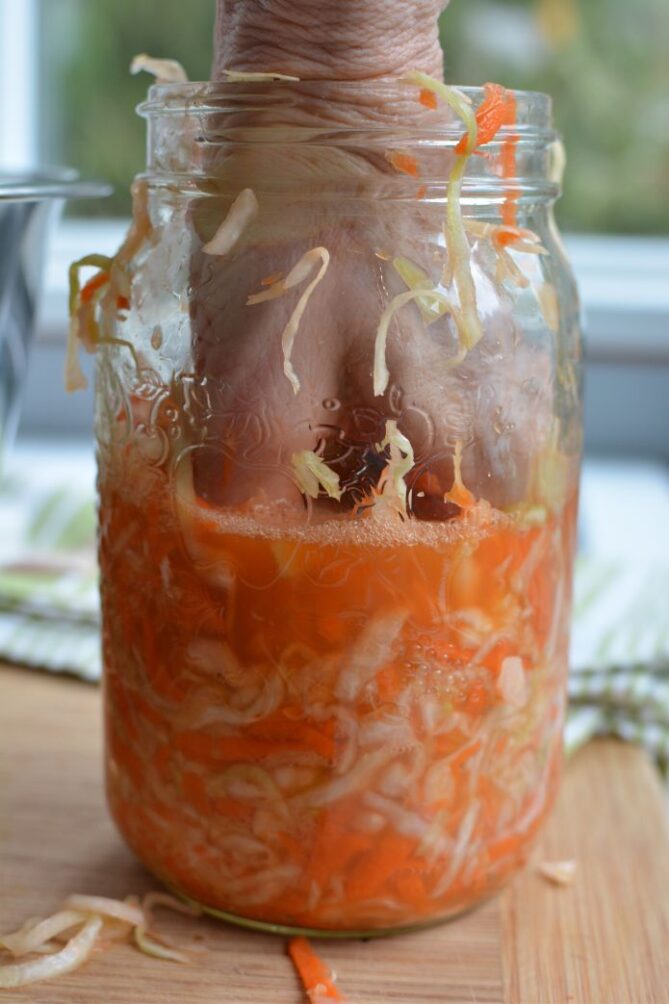

 This post may contain affiliate links which won’t change your price but will share some commission.
This post may contain affiliate links which won’t change your price but will share some commission.
